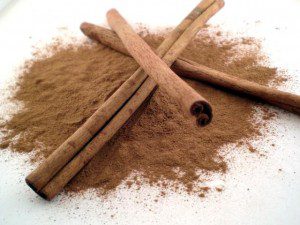By Sayer Ji
Contributing writer for Wake Up World
Cinnamon’s medicinal potential is as rich and complex as its flavor and aroma, with balancing blood sugar and fighting infection at the top of the list.
Cinnamon is a familiar spice, but few are aware of just how diverse are its medicinal properties. The US National Library of Medicine houses well over 1300 abstracts on the subject of the various forms of cinnamon’s potential health benefits.
GreenMedInfo.com has gathered together research on no less than 60 potential health benefits of this highly valued spice on our research page dedicated to the topic: Cinnamon Medicinal Properties.
First, it must be clarified that there are a wide range of plants whose bark are sold as cinnamon. The first though less used form is known as Cinnamomum verum (literally “true cinnamon”). It is sometimes called Ceylon (the ancient name of Sri Lanka) cinnamon, as it is named after the geographic region where it was first commonly cultivated. Due to its rarity, it is more expensive and harder to find on the market.
[pro_ad_display_adzone id=”110028″]
Other forms include:
- C. cassia (Cassia or Chinese cinnamon)
- C. burmannii ( Indonesian cinnamon)
- C. loureiroi (Vietnamese cinnamon)
One of the major differences between C. verum and varieties such as C. burmannii and C. cassia is that the latter types contain much higher levels of coumarin, a naturally occurring phytochemical with blood-thinning properties. This has prompted European health agencies to warn against consuming large amounts of cinnamon varieties such as cassia.[i] Natural blood-thinning activity, of course, within the proper context can be life-saving, but when mixed with already dangerous blood-thinning drugs such as aspirin, can be a recipe for disaster – all the more reason why folks using spices and herbs in ‘pharmacological’ or heroic doses should consult a medical herbalist, or physician with a nuanced understanding of the benefits and potential harms of using high-dose herbal therapies.
Another issue that the US buyer of spices must be fully aware of is the likelihood that, unless explicitly labelled ‘USDA certified organic’, the cinnamon they are purchasing was exposed to toxic levels of gamma irradiation in a controversial process known as “electronic” or “cold” pasteurization. To learn more about this serious threat to our food supply read: The Invisible Nuclear Threat in Non-Organic Food.
Lastly, be mindful of the differences between the powdered whole herb, various water or alcohol extracts, and the oil itself. Some of the studies below focus solely on the oil component (90% of the oil is the therapeutic substance known as cinnamaldehyde) whereas others use water soluble components. The information listed below is not provided as medical advice but to illustrate the vast potential natural substances have to be used in a therapeutic manner.
Blood Sugar Disorders
Probably the most well-known health benefit of cinnamon is for blood sugar disorders. And this is for good reason. There is now a rather substantial body of clinical and preclinical research showing that it may help to improve the condition of both type 2 and type 1 diabetics in the following ways:
- Type 2 diabetics: Improve fasting blood sugar,[ii] reduce glycated hemoglobin (A1C) and blood pressure,[iii] increase glucose optimization in a manner similar to metformin,[iv] [v]improve insulin signaling and sensitivity,[vi] [vii] and improve blood lipid profiles.[viii]
- Type 1 diabetics: Protect against hypertension,[ix] protect against diabetes-associated kidney damage,[x] suppress post-meal blood sugar elevations,[xi] and contribute to ongoing reduction in blood sugar.[xii]
Infections
While there is extant folk medical lore indicating that honey mixed with cinnamon can help relieve a sore throat, or fight off infection, few realize it has been confirmed to have extensive anti-infective properties against a wide range of bacteria, viruses and fungi.
It makes sense that cinnamon bark would protect against infection, as one of the major biological functions of plant bark is as defense against predation (ie. infection).
What follows is an impressive range of pathogens that appear to succumb to cinnamon:
- Aspergillus niger[xiii]
- Campylobacter Infections[xiv]
- Candida Infection[xv]
- Coronaviridae (SARS-associated) Infections[xvi]
- Escherichia coli Infections[xvii]
- H1N1 Infection[xviii]
- Head Lice[xix]
- HIV Infections[xx]
- Insect Bites: Repellent[xxi]
- Klebsiella Infections[xxii]
- Legionnaires’ disease[xxiii]
- MRSA[xxiv]
- Pseudomonas aeruginosa[xxv]
- Staphylococcal Infections[xxvi]
Like many natural spices that have been used for thousands of years, we are only now just beginning to comprehend through scientific research how important they are, not simply for flavoring our foods but for helping keep us free of disease.
For an impressive list of traditional spices and herbs that have now been confirmed to have medicinal properties by empirical science, view GreenMedInfo’s article on the topic: When Science Confirms Tradition.
Resources:
- [i] Harris, Emily. German Christmas Cookies Pose Health Danger. National Public Radio. Retrieved 2007-05-01
- [ii] Paul A Davis, Wallace Yokoyama. Cinnamon intake lowers fasting blood glucose: meta-analysis.J Med Food. 2011 Sep ;14(9):884-9. Epub 2011 Apr 11. PMID: 21480806
- [iii] R Akilen, A Tsiami, D Devendra, N Robinson. Glycated haemoglobin and blood pressure-lowering effect of cinnamon in multi-ethnic Type 2 diabetic patients in the UK: a randomized, placebo-controlled, double-blind clinical trial. Photochem Photobiol. 2004 Nov-Dec;80(3):579-82. PMID: 20854384
- [iv] Wei Zhang, Yan-cheng Xu, Fang-jian Guo, Ye Meng, Ming-li Li. Anti-diabetic effects of cinnamaldehyde and berberine and their impacts on retinol-binding protein 4 expression in rats with type 2 diabetes mellitus. Chin Med J (Engl). 2008 Nov 5;121(21):2124-8. PMID: 19080170
- [v] Richard A Anderson, C Leigh Broadhurst, Marilyn M Polansky, Walter F Schmidt, Alam Khan, Vincent P Flanagan, Norberta W Schoene, Donald J Graves. Isolation and characterization of polyphenol type-A polymers from cinnamon with insulin-like biological activity. Mol Cancer Ther. 2007 Mar;6(3):1013-21. Epub 2007 Mar 5. PMID: 14709014
- [vi] Bolin Qin, Masaru Nagasaki, Ming Ren, Gustavo Bajotto, Yoshiharu Oshida, Yuzo Sato. Cinnamon extract (traditional herb) potentiates in vivo insulin-regulated glucose utilization via enhancing insulin signaling in rats. Diabetes Res Clin Pract. 2003 Dec;62(3):139-48. PMID:14625128
- [vii] Bolin Qin, Kiran S Panickar, Richard A Anderson. Cinnamon: potential role in the prevention of insulin resistance, metabolic syndrome, and type 2 diabetes. J Diabetes Sci Technol. 2010 May;4(3):685-93. Epub 2010 May 1. PMID: 20513336
- [viii] P Subash Babu, S Prabuseenivasan, S Ignacimuthu. Cinnamaldehyde–a potential antidiabetic agent. Phytomedicine. 2007 Jan;14(1):15-22. Epub 2006 Nov 30. PMID: 17140783
- [ix] Hany M El-Bassossy, Ahmed Fahmy, Dina Badawy. Cinnamaldehyde protects from the hypertension associated with diabetes. Food Chem Toxicol. 2011 Aug 5. Epub 2011 Aug 5. PMID: 21840367
- [x] Awanish Mishra, Rajbir Bhatti, Amarjit Singh, Mohan Paul Singh Ishar. Ameliorative effect of the cinnamon oil from Cinnamomum zeylanicum upon early stage diabetic nephropathy. Planta Med. 2009 Oct 29. Epub 2009 Oct 29. PMID: 19876811
- [xi] H Mohamed Sham Shihabudeen, D Hansi Priscilla, Kavitha Thirumurugan. Cinnamon extract inhibitsα-glucosidase activity and dampens postprandial glucose excursion in diabetic rats.Nutr Metab (Lond). 2011 ;8(1):46. Epub 2011 Jun 29. PMID: 21711570
- [xii] GreenMedInfo.com, Cinnamon’s Hypoglycemic Properties
- [xiii] V C Pawar, V S Thaker. In vitro efficacy of 75 essential oils against Aspergillus niger. Mycoses. 2006 Jul;49(4):316-23. PMID: 16784447
- [xiv] Sadhana Ravishankar, Libin Zhu, Bibiana Law, Lynn Joens, Mendel Friedman. Plant-derived compounds inactivate antibiotic-resistant Campylobacter jejuni strains. J Food Prot. 2008 Jun;71(6):1145-9. PMID: 18592739
- [xv] GreenMedInfo.com, Cinnamon’s Anti-Candida Properties
- [xvi] Min Zhuang, Hong Jiang, Yasuhiro Suzuki, Xiaoguang Li, Peng Xiao, Takashi Tanaka, Hong Ling, Baofeng Yang, Hiroki Saitoh, Lianfeng Zhang, Chuan Qin, Kazuo Sugamura, Toshio Hattori.Procyanidins and butanol extract of Cinnamomi Cortex inhibit SARS-CoV infection. Antiviral Res. 2009 Apr;82(1):73-81. Epub 2009 Feb 11. PMID: 19428598
- [xvii] Rosina Khan, Barira Islam, Mohd Akram, Shazi Shakil, Anis Ahmad, S Manazir Ali, Mashiatullah Siddiqui, Asad U Khan. Antimicrobial activity of five herbal extracts against multi drug resistant (MDR) strains of bacteria and fungus of clinical origin. Molecules. 2009 Feb 4;14(2):586-97. PMID: 19214149
- [xviii] K Hayashi, N Imanishi, Y Kashiwayama, A Kawano, K Terasawa, Y Shimada, H Ochiai. Inhibitory effect of cinnamaldehyde, derived from Cinnamomi cortex, on the growth of influenza A/PR/8 virus in vitro and in vivo. Antiviral Res. 2007 Apr;74(1):1-8. Epub 2007 Jan 26 PMID: 17303260
- [xix] Young-Cheol Yang, Hoi-Seon Lee, Si Hyeock Lee, J Marshall Clark, Young-Joon Ahn. Ovicidal and adulticidal activities of Cinnamomum zeylanicum bark essential oil compounds and related compounds against Pediculus humanus capitis (Anoplura: Pediculicidae). Int J Parasitol. 2005 Dec;35(14):1595-600. Epub 2005 Sep 15. PMID: 16188263
- [xx] GreenMedInfo.com, Cinnamon’s anti-HIV potential
- [xxi] Adrian Martin Pohlit, Norberto Peporine Lopes, Renata Antonaci Gama, Wanderli Pedro Tadei, Valter Ferreira de Andrade Neto. Patent literature on mosquito repellent inventions which contain plant essential oils–a review. Planta Med. 2011 Apr ;77(6):598-617. Epub 2011 Feb 15. PMID: 21328177
- [xxii] GreenMedInfo.com, Cinnamon’s anti-Klebsiella properties.
- [xxiii] Ching-Wen Chang, Wei-Lung Chang, Shang-Tzen Chang. Influence of pH on bioactivity of cinnamon oil against Legionella pneumophila and its disinfection efficacy in hot springs.Brain Res. 2006 Nov 20;1120(1):183-90. Epub 2006 Sep 20. PMID: 18945470
- [xxiv] GreenMedInfo.com, Cinnamon’s anti-MRSA properties
- [xxv] Y K Ibrahim, M S Ogunmodede. Growth and survival of Pseudomonas aeruginosa in some aromatic waters. Pharm Acta Helv. 1991;66(9-10):286-8. PMID: 1758905
- [xxvi] Titik Nuryastuti, Henny C van der Mei, Henk J Busscher, Susi Iravati, Abu T Aman, Bastiaan P Krom.Effect of cinnamon oil on icaA expression and biofilm formation by Staphylococcus epidermidis. Appl Environ Microbiol. 2009 Nov;75(21):6850-5. Epub 2009 Sep 11. PMID: 19749058
Recommended articles by Sayer Ji:
- Brain Regeneration: Why It’s Real and How To Do It
- Research: Garlic is an Effective Natural Treatment for Heart Disease
- Wi-Fi Devices Increase Mercury Release From Dental Amalgams
- “Killer Germs” Obliterated by Medicinal Smoke Smudging, Study Reveals
- Turmeric’s ‘Smart Kill’ Properties Put Chemo & Radiation To Shame
- Beet Juice Boosts Cognitive Function In One Dose
- The Amazing Healing Properties of Apples
- 6 Bodily Tissues That Can Be Regenerated Through Nutrition
- How Turmeric Can Save the Aging Brain From Dementia and Premature Death
- Eating Wheat Feeds Disease-Causing Gut Bacteria, Study Suggests
About the author:
Sayer Ji is the founder of Greenmedinfo.com, a reviewer at the International Journal of Human Nutrition and Functional Medicine, Co-founder and CEO of Systome Biomed, Vice Chairman of the Board of the National Health Federation, and Steering Committee Member of the Global Non-GMO Foundation.
For more, visit GreenMedInfo.com and Facebook.com/GreenMedInfo, or sign up for GreenMedInfo’s free e-Newsletter.
© July 10th, 2013 GreenMedInfo LLC. This work is reproduced and distributed with the permission of GreenMedInfo LLC. Want to learn more from GreenMedInfo? Sign up for their newsletter here.
[pro_ad_display_adzone id=”110027″]








